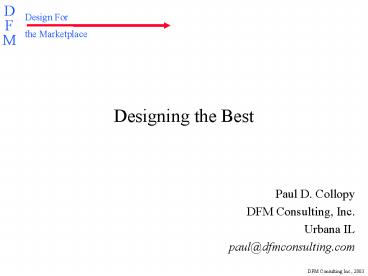Designing the Best PowerPoint PPT Presentation
1 / 23
Title: Designing the Best
1
Designing the Best
- Paul D. Collopy
- DFM Consulting, Inc.
- Urbana IL
- paul_at_dfmconsulting.com
2
Declining Enthusiasm for Complex Systems
Production Tactical Aircraft
1,000,000
100,000
10,000
Cost (2001 Constant thousands)
1,000
100
1900
1920
1940
1960
1980
2000
2020
Year Entered Service
Much data drawn from Augustines Laws, Norm
Augustine, 1998, p. 105
3
Hoping for little Achieving less
Typical Cost Growth and Performance Erosion
design
testing
production
-5
50
Cost
Performance
Time
4
Designing the Best
- What is Designing the Best?
- Engineering Complex Systems
- Comparison to Good Enough Design
- Complex Adaptive Systems
- Conclusion
5
Understanding Better
Ordinal Function
Rank
Attributes
Design B
Design C
Design A
92
Efficiency
90
89
750
Weight
700
600
1200
Reliability
1500
1400
Maintainability
9.5
7.8
8.0
600
Maintenance Cost
500
530
Can also include development time, technical
risk, etc.
10
Support Equipment
12
12
0.10
Radar Cross-Section
0.11
0.11
1.2
InfraRed Signature
1.4
1.5
690
Manufacturing Cost
700
750
1st 2nd 3rd
Rank
6
Good Enough versus
Best
Requirements
Increasing Score
lt 30 M unit mfg cost
Limit of Feasibility
Cost
Cost
lt 30,000 lbs. weight
Best
(0,0)
(0,0)
Weight
Weight
Traditional Spec Method
Designing the Best
7
Engineering Complex Systems
- History of Complex Systems
- Superplans
- Modular Design
- Coordinated Design
8
The Rise of Complex Systems
Complexity is a measure of the number of parts
and the design interactions among the parts
aircraft
networks
Complexity
automobiles
launch systems
ships
power gen
software
aircraft
computers
spacecraft
networks
1900
1940
1950
1960
1990
2000
1910
1920
1930
1970
1980
After WW II, we discovered the ability to create
complex systems by building formal engineering
organizations with thousands of members
9
Complex System Design Superplan
- The design of a system is a set of plans
- for manufacturing the system
- for operating the system
- maintaining, distributing, marketing, and more
- The design of a complex system is distributed
across many minds - can be beyond any individuals comprehension
- plans link minds via overlaps
10
Complex Systems use Hierarchical Modular Designs
Specification Method (Good Enough) promises
Functionality
11
Coordinated Design Designing the Best
12
Value Gradient for Coordinated Module Design
Module Design Value is Commensurate with System
Design Value
x
13
Comparison to Good Enough Design Methods
- Example of Value Conflicts
- Visualizing Lack of Coordination
- Cumulative Impact of Lack of Coordination
- Formalization
- Symptoms of Problems in the Good Enough Method
- Search for Knees in Curves
- Aversity to Technical Risk
14
Good Enough Method Fosters Value Conflicts
Brake Material 11,000 - 90 lbs. Rudder -
10,000 190 lbs. Net Impact 1,000 100
lbs.
Differences in perceived value within a design
team lead to choices that, taken together, are
clearly lose-lose
15
Good Enough Method is Uncoordinated
Revealed Preferences
16
Coordinated Values Achieve Design Potential
Design Potential
Value A
Good Enough Method
Designing the Best
Value B
17
Formalization of Better
Net Value is a potential function in attribute
space. Gradients of Value show the direction of
improvement
Lines of Constant Net Value
Better
Performance
Spec Design
Space of Possible Designs
Cost
18
The Knee in the Curve Guessing at Values
Goodness ?
Performance
Space of Possible Designs
Cost
19
Settling for Minimum Risk
Design
Maintenance Cost
Typical Requirement
Reasonable Expectation
20
Complex Adaptive Systems
- Definition
- Complex Many interacting parts, complex
interactions - Adaptive Patterned by a schema (design) which
evolves in response to the environment and the
system itself - Autonomous Emergent behavior, unplanned and
unpredictable (ungovernable) - Evolution of Engineered Systems
- Managing Autonomous Evolution
21
Evolution of Complex Adaptive Systems
Increasing Value
Value Landscape
22
Autonomous Development
Managing Complex System Development is like
planting a tree
not like building a house
You may provide resources to encourage fruitful
development, and you may prune, or stop the
development, but you cannot anticipate or force
the exact outcome
23
Conclusion Designing the Best
- Know Yourself
- Understand why one design is better than another
- Clearly, objectively, consistently, formally
- Requires articulation of values (worthwhile
exercise for 1 billion pgm) - No need to search for knee in the curve
- Benefit
- gt 50 reduction in cost, or equivalent
improvement in performance - Robustness in the face of technical risk
- Reduced development cost and time
- Fully utilize our technical edge

